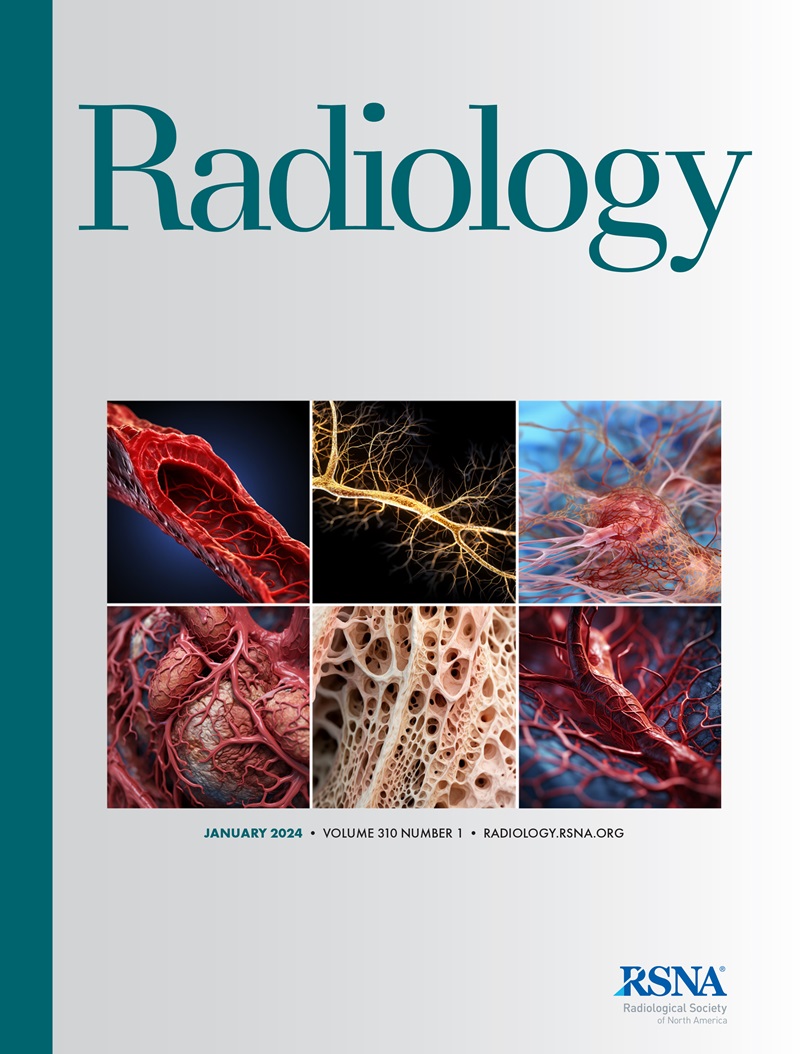超快速与标准二维动态对比增强乳房MRI的个体内比较。
IF 12.1
1区 医学
Q1 RADIOLOGY, NUCLEAR MEDICINE & MEDICAL IMAGING
引用次数: 0
摘要
背景:超快乳腺MRI有望通过避免因背景实质增强(BPE)而导致的掩蔽来提高癌症的显著性,并改进增强病变的分类。然而,已发表的研究系统地惩罚了标准动态对比增强(DCE) MRI,因为它们将超快MRI集成到现有的DCE方案中,因此DCE MRI的对比后采集仅在完成超快MRI后开始。目的比较超快MRI与标准DCE MRI对乳腺增强病变的显著性和分类,两种方法都包括早期造影后阶段。材料与方法回顾性分析2021年9月至2023年1月31名女性(中位年龄48岁[IQR, 39-51岁])。女性在1.5 T时接受DCE MRI检查,并在2天内使用超快MRI进行第二次对比增强检查,以进一步诊断难以解释的强化病变和/或BPE。DCE MRI在注射0.1 mmol/kg gadobutrol前和注射后分别获得1次和4次二维梯度回波序列(0.61 × 0.61 × 3.0 mm空间分辨率,60秒/动态帧)。对于超快MRI,在注射0.1 mmol/kg gadobutrol前、中、后90秒内获得压缩感加速三维梯度回波序列(0.92 × 0.97 × 2.5 mm空间分辨率,每个锁孔动态帧4秒)。两名乳腺放射科医生独立评估BPE、图像质量、增强病灶的显著性和形态学,并分析增强动力学(超快MRI:最大斜率和增强时间;DCE MRI:冲洗率和时间进程模式)。结果31例患者62个乳房共报告59个增强病灶。与DCE MRI相比,超快MRI的BPE评分平均低0.8分(平均,2.5±1.2 [SD] vs 3.3±1.2;P < 0.001)。尽管BPE轻度降低,但病变显著性在超快MRI上的评分低于DCE MRI(平均值,3.5±1.3 vs 4.1±1.0;P = .001),图像质量也是如此(平均值,2.3±0.9 vs 4.1±0.8;P < 0.001)。病变形态(形状、边缘、内部结构)在超快MRI上评价较差(均P < 0.05)。与DCE MRI相比,超快MRI获得的动力学参数并没有改善增强病变的分类:在超快MRI中,恶性病变的增强时间比良性病变短(P = 0.01),但最大斜率没有差异,而在DCE MRI中,恶性病变和良性病变的冲洗率和时间过程模式都不同(P = 0.01)。在这个期望超快MRI比DCE MRI提供诊断优势的富集队列中,超快MRI实际上降低了病变的显著性,并没有改善病变的分类。©RSNA, 2025本文可获得补充材料。参见本期柯茨和雅各布斯的社论。本文章由计算机程序翻译,如有差异,请以英文原文为准。
Intraindividual Comparison of Ultrafast versus Standard Two-dimensional Dynamic Contrast-enhanced Breast MRI.
Background Ultrafast breast MRI promises to improve conspicuity of cancers by avoiding masking due to background parenchymal enhancement (BPE) and to improve classification of enhancing lesions. However, published studies systematically penalized standard dynamic contrast-enhanced (DCE) MRI because they integrated ultrafast MRI into existing DCE protocols, such that postcontrast acquisitions of DCE MRI began only after completion of ultrafast MRI. Purpose To perform an intraindividual comparison of conspicuity and classification of enhancing breast lesions with ultrafast MRI versus standard DCE MRI, where both methods included the early postcontrast phase. Materials and Methods This was a retrospective analysis of 31 women (median age, 48 years [IQR, 39-51 years]) from September 2021 to January 2023. Women underwent DCE MRI at 1.5 T and, within 2 days, a second contrast-enhanced examination using ultrafast MRI, for further diagnostic assessment of difficult-to-interpret enhancing lesions and/or BPE. For DCE MRI, a two-dimensional gradient-echo series (0.61 × 0.61 × 3.0-mm spatial resolution, 60 seconds per dynamic frame) was obtained once before and four times after injection of 0.1 mmol/kg gadobutrol. For ultrafast MRI, a compressed-sense accelerated three-dimensional gradient-echo series (0.92 × 0.97 × 2.5-mm spatial resolution, 4 seconds per keyhole dynamic frame) was obtained over 90 seconds before, during, and after injection of 0.1 mmol/kg gadobutrol. Two breast radiologists independently rated BPE, image quality, and conspicuity and morphology of enhancing lesions, and enhancement kinetics were analyzed (ultrafast MRI: maximum slope and time to enhancement; DCE MRI: wash-in rate and time course pattern). Results A total 59 enhancing lesions were reported in the 62 breasts of the 31 patients. BPE ratings were on average 0.8 points lower at ultrafast versus DCE MRI (mean, 2.5 ± 1.2 [SD] vs 3.3 ± 1.2; P < .001). Despite this mild reduction in BPE, lesion conspicuity was rated lower at ultrafast than at DCE MRI (mean, 3.5 ± 1.3 vs 4.1 ± 1.0; P = .001), as was image quality (mean, 2.3 ± 0.9 vs 4.1 ± 0.8; P < .001). Lesion morphology (shape, margin, internal architecture) was less assessable at ultrafast MRI (all P < .05). Kinetic parameters derived from ultrafast MRI did not improve classification of enhancing lesions compared with those derived from DCE MRI: At ultrafast MRI, time to enhancement was shorter for malignant versus benign lesions (P = .01), but maximum slope did not differ, whereas at DCE MRI, both wash-in rate and time course pattern differed between malignant and benign lesions (both P = .01). Conclusion In this enriched cohort in which ultrafast MRI was expected to provide diagnostic advantages over DCE MRI, ultrafast MRI in fact led to reduced lesion conspicuity and did not improve lesion classification. © RSNA, 2025 Supplemental material is available for this article. See also the editorial by Cotes and Jacobs in this issue.
求助全文
通过发布文献求助,成功后即可免费获取论文全文。
去求助
来源期刊

Radiology
医学-核医学
CiteScore
35.20
自引率
3.00%
发文量
596
审稿时长
3.6 months
期刊介绍:
Published regularly since 1923 by the Radiological Society of North America (RSNA), Radiology has long been recognized as the authoritative reference for the most current, clinically relevant and highest quality research in the field of radiology. Each month the journal publishes approximately 240 pages of peer-reviewed original research, authoritative reviews, well-balanced commentary on significant articles, and expert opinion on new techniques and technologies.
Radiology publishes cutting edge and impactful imaging research articles in radiology and medical imaging in order to help improve human health.
 求助内容:
求助内容: 应助结果提醒方式:
应助结果提醒方式:


